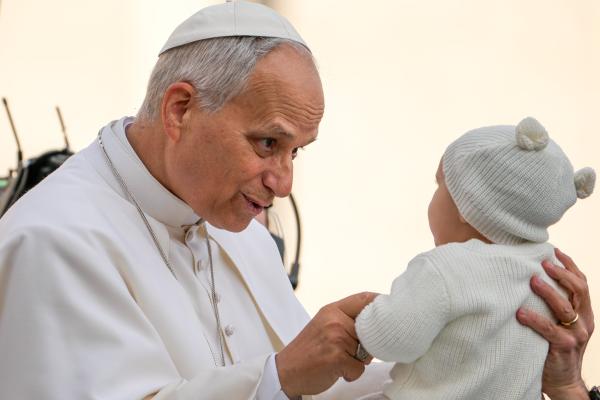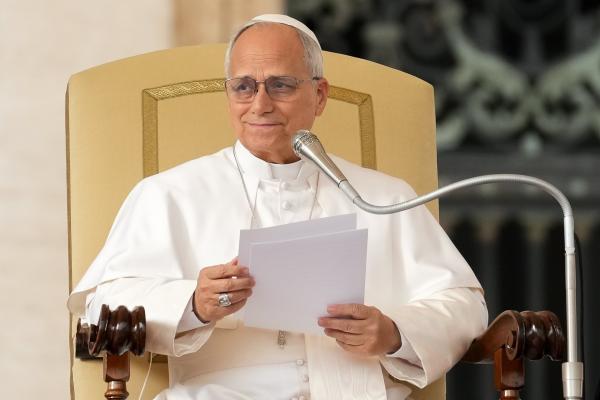Ancient word: Jews, Christians study shared past in Vatican manuscripts
The Vatican Library contains one of the most important collections of Hebrew manuscripts in the world and a new interfaith study program has been launched that brings Jewish and Christian scholars together to rediscover this heritage.
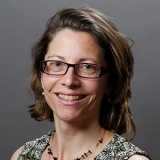 Carol Glatz
Carol Glatz
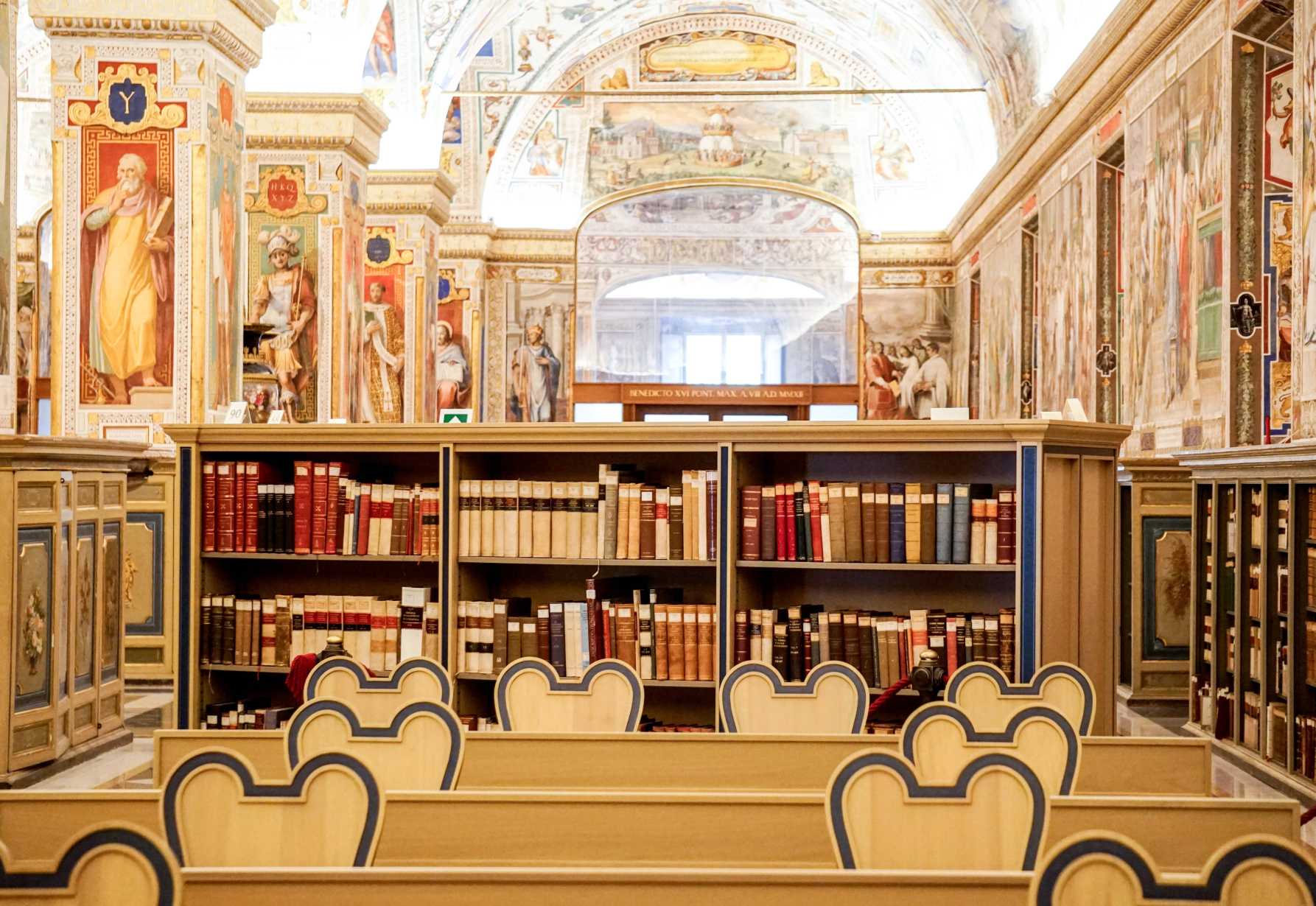
The Sistine hall, seen in this July 19, 2023, photograph, is one of a number of rooms in the Vatican Library. Formally established in 1475, the library is one of the oldest in the world whose important collections of ancient and historical texts and manuscripts are open to qualified researchers and scholars. (CNS photo/Carol Glatz)
VATICAN CITY (CNS) -- From a dark past of once allowing and ordering the censoring, banning and burning of the Talmud and other Hebrew texts, the Vatican has deepened its decades of fruitful dialogue and cooperation with Jewish leaders with a new interfaith study program.
Some 20 Jewish and Christian scholars began a three-month hybrid course in mid-July at the Vatican Library to dig into more than 1,000 years of teachings contained in more than 800 ancient Hebrew manuscripts from the 9th to 16th centuries housed in its collections.
Launching the start of the program at a news conference in the library's Barberini hall July 19, Claudio Pszemiarower, president of the Latin American Rabbinical Seminary, called the joint initiative between the Vatican and the seminary "historic."
The scholar-students of different backgrounds and faiths will follow lectures online and in person by preeminent Jewish and Christian experts, and study together to share and grow in their spiritual and academic interests, he said.
Archbishop Angelo Zani, Vatican archivist and librarian, said the Vatican Library, which is open to qualified scholars worldwide, is a place of encounter and dialogue in line with Pope Francis' emphasis on creating a more fraternal world through education and by offering places for different cultures to come together.
The unique initiative came about thanks to the generosity of Pope Francis, Rabbi Ariel Stofenmacher, rector of the Latin American Rabbinical Seminary in Buenos Aires, told Catholic News Service at the program's launch at the library.
The future pope, "Cardinal Jorge (Bergoglio) was very well-known to us at the seminary," which is an important center for Jewish academic and spiritual formation in Latin America, he said. The rector at the time was also the pope's good friend, Rabbi Abraham Skorka.
When Rabbi Stofenmacher led a delegation from the rabbinical seminary to visit Rome in December, "the pope asked us what we wanted to do specifically" during their visit "and I said I wanted to look at the manuscripts" in the library "because it is our heritage."
"So he graciously agreed," the rabbi said. After seeing the collection, Rabbi Stofenmacher thought, "we should do more. So we suggested to the pope and the prefect (of the library) to do a program" that taps into "this absolute richness that the Vatican has here."
"They amazingly agreed and so here we are!" he beamed. "It's like a dream come true."
While the library's collection is not one of the largest, it is one of the most important in the world, especially for Hebrew manuscripts, U.S.-born Rabbi David Golinkin, president of The Schechter Institutes in Jerusalem, told CNS.
It includes: important commentaries on different parts of the Talmud; one of only two manuscripts in the world of the Jerusalem Talmud; and a 9th- or 10th-century manuscript of the Sifra, which is "the oldest midrash that exists and might be the oldest Hebrew manuscript in existence, other than the Dead Sea Scrolls," he said.
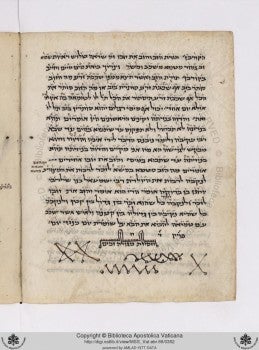
One reason these early manuscripts are so important is they reflect the rich variety in Jewish traditions and teachings, Rabbi Claudio Kupchik, senior rabbi of Temple Beth El of Cedarhurst, New York, told CNS.
"The talmudic texts were transmitted orally in a fluid form until quite late," sometimes past the 9th century, and "that orality allowed for a lot of variation," which was then written down by hand in manuscript form, he said.
With the advent of the printing press in the 15th century, editors then had to either "condense" different versions or choose just one version to put into print, Rabbi Kupchik said. While printing made texts more widely and cheaply available, "the rainbow of variant texts" found in "the various schools of manuscripts" were lost with the printed form.
Printing also made texts vulnerable to censorship, he said. "Some editions of the Talmud were subject to the censorship of the (Catholic) church in the past," and the altered texts and missing passages can be rediscovered in the original manuscripts.
Finally, "a lot was lost with persecutions" and burnings of the Talmud, Rabbi Kupchik said.
The first infamous mass burning of the Talmud took place in Paris in 1242, ordered by King Louis IX. Condemnations of the Talmud were issued over the following centuries by a number of popes, reaching fever pitch during the Counter-Reformation and the Roman Inquisition.
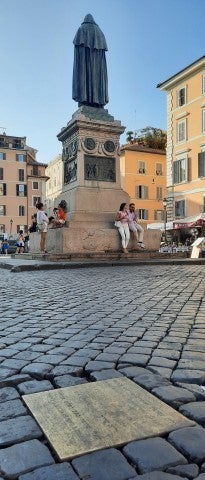
Pope Julius III ordered the confiscation and burning of the Talmud and other Jewish texts, resulting in a public burning Sept. 9 on Rosh Hashanah in 1553 in Rome's Campo dei Fiori.
Today, a brass plaque in Italian, with two quotations in Hebrew, marks the site, in the shadow of a statue dedicated to Giordano Bruno, a philosopher and cosmologist condemned by the Inquisition and burned at the stake in the square in 1600.
Rabbi Golinkin estimates "around one third of the Hebrew manuscripts in the Vatican were captured in war in Germany in, I believe, Heidelberg" in the 17th century as part of military campaigns between the Spanish Empire and Protestant states.
Others were "confiscated by the Catholic Church from individual Jews" all over Europe and around the Mediterranean at many different times, he said, "so there's no country to repatriate them to, though, in theory, they could repatriate them to a specific family that owned the manuscript. But I don't think that's going to happen."
For now, the Hebrew manuscripts are well-preserved, well-cataloged, available online and in person to scholars. And the new joint study program between the Vatican and the rabbinical seminary invites Jews and Christians to study them together.
The dialogue and collaboration "since 'Nostra Aetate' of the Second Vatican Council is allowing us to rediscover not only the wealth we can gather from our relationship with each other but also the wealth of our traditions and texts," Rabbi Kupchik said.
"The texts are a window to the past and that past had wonderful blessings and sometimes difficulties," he said. "We need to try to recover the blessings and understand the difficulties of the past" in order to understand "why things evolved the way they did and which kind of choices we ought to make" for a better future.
Rabbi Stofenmacher said this initiative is only the beginning as he is calling for a similar program for Muslim, Jewish and Christian scholars to study the Vatican's Islamic texts together. "When there's collaboration, the sky's the limit."
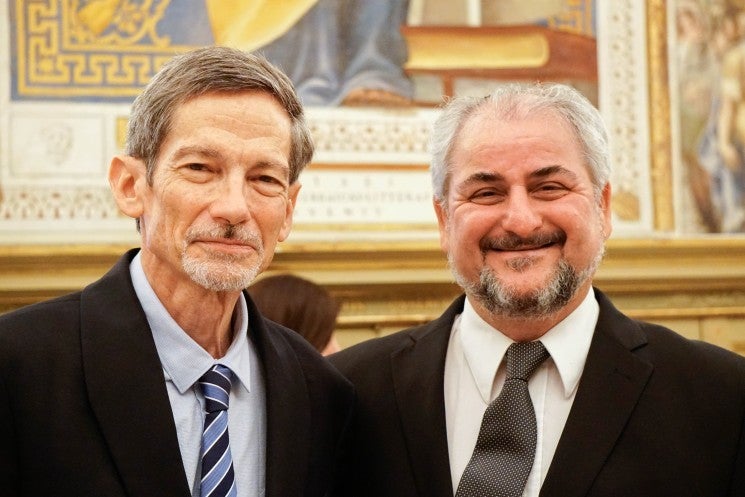
U.S.-born Rabbi David Golinkin, president of The Schechter Institutes in Jerusalem, left, poses for a photograph with Argentine Rabbi Claudio Kupchik, senior rabbi of Temple Beth El of Cedarhurst, N.Y., right, in the Sistine hall of the Vatican Library July 19, 2023. (CNS photo/Carol Glatz)
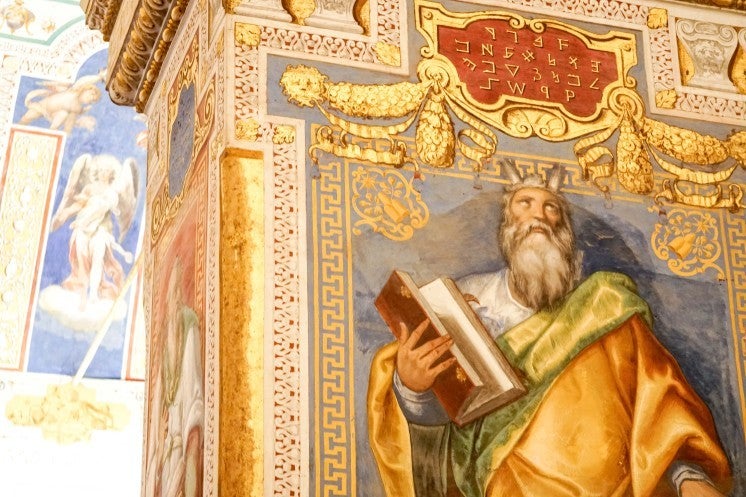
A fresco depicting Moses can be seen in this photo taken in the Sistine hall of the Vatican Library July 19, 2023. (CNS photo/Carol Glatz)
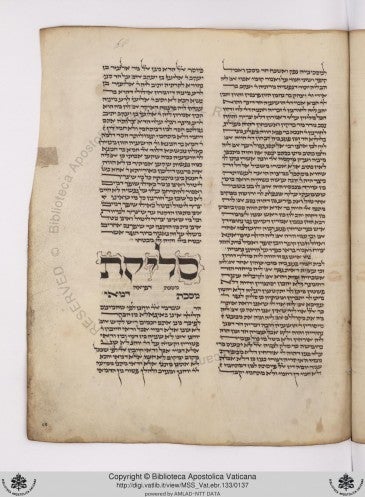
Pictured is a photographic reproduction of a Hebrew manuscript from the late 13th or early 14th century housed in the collections of the Vatican Library. The old manuscript is the Jerusalem Talmud -- one of only two manuscripts in the world of the Jerusalem Talmud. (CNS photo/ © 2023 Vatican Library)
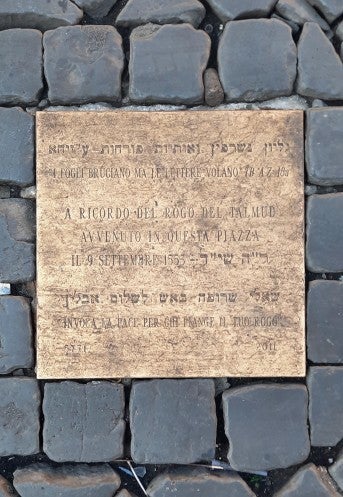
A brass plaque can be seen embedded in cobblestones in Rome's Campo dei Fiori square in this July 26, 2023, photograph. Written in Italian, with quotations in Hebrew, it marks the site where copies of the Talmud and other Jewish texts were publicly burned Sept. 9 on Rosh Hashanah in 1553 after Pope Julius III ordered their confiscation and destruction. (CNS photo/Carol Glatz)
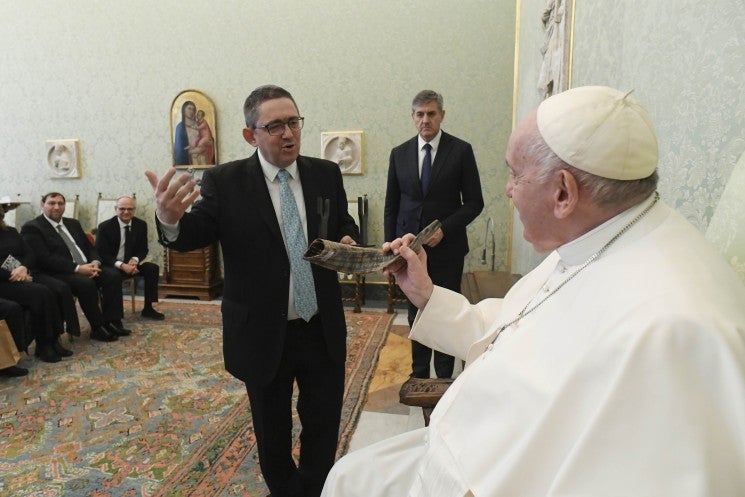
Rabbi Ariel Stofenmacher, rector of the Latin American Rabbinical Seminary, gives Pope Francis a shofar, which is a musical horn typically made of a ram's horn, during an audience with the pope at the Vatican Dec. 2, 2022. The rector led a delegation from the seminary, which is based in Buenos Aires, Argentina, to Rome in late 2022. (CNS photo/Vatican Media)
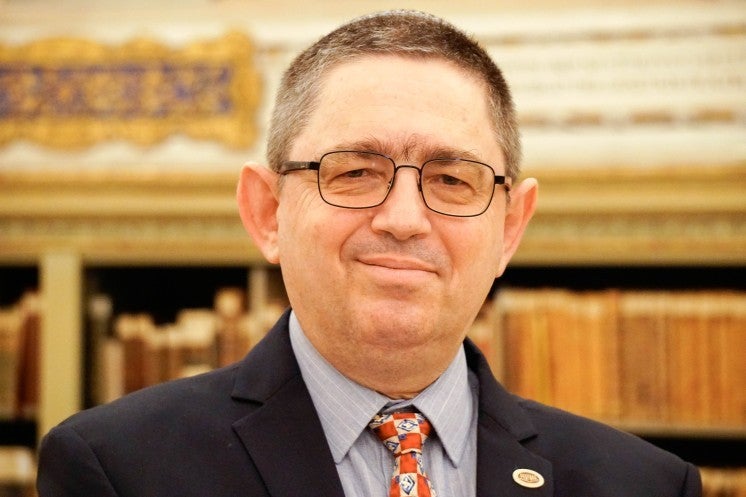
Rabbi Ariel Stofenmacher, rector of the Latin American Rabbinical Seminary in Buenos Aires, Argentina, poses for a photograph in the Sistine hall at the Vatican Library July 19, 2023. He came up with the idea to create an interfaith program with the Vatican Library that brings Jews and Christians together to study the Vatican's Hebrew manuscripts. (CNS photo/Carol Glatz)

A ceiling fresco dedicated to Pope Sixtus V can be seen in the Sistine hall of the Vatican Library July 19, 2023. The pope commissioned the construction of a new building for the library around 1587. Among the frescoed depictions are symbols of the pope's coat of arms: a lion holding pears and three mountains topped by a star. (CNS photo/Carol Glatz)

